Investigate the Equivalence of Neutrons and Protons in Single Event Effects Testing: A Geant4 Study
Abstract
:1. Introduction
2. Materials and Methods
2.1. Monte Carlo Simulation
2.2. Material Structure
2.3. Data Analysis
3. Results and Discussions
3.1. LET Difference between Neutrons and Protons
3.2. Secondary Particle Yield Difference between Neutron and Proton
3.3. LET Difference between Layer Structures with and without SiGe
3.4. Secondary Particle Yields Difference between Layer Structure with and without SiGe
3.5. Energy Deposited Difference between Neutrons and Protons
4. Conclusions
Author Contributions
Funding
Acknowledgments
Conflicts of Interest
References
- Dong, A.X.; Gwinn, R.P.; Warner, N.M.; Caylor, L.M.; Doherty, M.J. Mitigating bit flips or single event upsets in epilepsy neurostimulators. Epilepsy Behav. Case Rep. 2016, 5, 72–74. [Google Scholar] [CrossRef] [PubMed] [Green Version]
- Seifert, N.; Jahinuzzaman, S.; Velamala, J.; Ascazubi, R.; Patel, N.; Gill, B.; Basile, J.; Hicks, J. Soft error rate improvements in 14-nm technology featuring second-generation 3D tri-gate transistors. IEEE Trans. Nucl. Sci. 2015, 62, 2570–2577. [Google Scholar] [CrossRef]
- Wie, B.S.; LaBel, K.A.; Turflinger, T.L.; Wert, J.L.; Foster, C.C.; Reed, R.A.; Kostic, A.D.; Moss, S.C.; Guertin, S.M.; Pankuch, M.; et al. Evaluation and Application of U.S. Medical Proton Facilities for Single Event Effects Test. IEEE Trans. Nucl. Sci. 2015, 62, 2490–2497. [Google Scholar] [CrossRef]
- O’Neill, P.M.; Badhwar, G.D.; Culpepper, W.X. Internuclear cascade-evaporation model for LET spectra of 200 MeV protons used for parts testing. IEEE Trans. Nucl. Sci. 1998, 45, 2467–2474. [Google Scholar] [CrossRef] [PubMed]
- Javanainen, A.; Malkiewicz, T.; Perkowski, J.; Trzaska, W.H.; Virtanen, A.; Berger, G.; Hajdas, W.; Lyapin, V.; Kettunen, H.; Mutterer, M.; et al. Linear Energy Transfer of Heavy Ions in Silicon. IEEE Trans. Nucl. Sci. 2007, 54, 1158–1162. [Google Scholar] [CrossRef]
- Dodd, P.E.; Shaneyfelt, M.R.; Felix, J.A.; Schwank, J.R. Production and propagation of single-event transients in high-speed digital logic ICs. IEEE Trans. Nucl. Sci. 2004, 51, 3278–3284. [Google Scholar] [CrossRef]
- Bagatin, M.; Gerardin, S.; Paccagnella, A.; Visconti, A.; Virtanen, A.; Kettunen, H.; Costantino, A.; Ferlet-Cavrois, V.; Zadeh, A. Single Event Upsets Induced by Direct Ionization from Low-Energy Protons in Floating Gate Cells. IEEE Trans. Nucl. Sci. 2017, 64, 464–470. [Google Scholar] [CrossRef] [Green Version]
- Acosta Urdaneta, G.C.; Bisello, D.; Esposito, J.; Mastinu, P.; Prete, G.; Silvestrin, L.; Wyss, J. ANEM: A rotating composite target to produce an atmospheric-like neutron beam at the LNL SPES facility. In International Journal of Modern Physics: Conference Series; World Scientific Publishing Company: Singapore, 2016; Volume 44, p. 1660207. [Google Scholar] [CrossRef] [Green Version]
- Agostinelli, S.; Allison, J.; Amako, K.A.; Apostolakis, J.; Araujo, H.; Arce, P.; Asai, M.; Axen, D.; Banerjee, S.; Behner, F.; et al. Geant4—A simulation toolkit. Nucl. Instrum. Methods Phys. Res. Sect. A Accel. Spectrometers Detect. Assoc. Equip. 2003, 506, 250–303. [Google Scholar] [CrossRef] [Green Version]
- Foley, K.; Seifert, N.; Velamala, J.B.; Bennett, W.G.; Gupta, S. IRT: A modeling system for single event upset analysis that captures charge sharing effects. In Proceedings of the 2014 IEEE International Reliability Physics Symposium, Waikoloa, HI, USA, 1–5 June 2014; p. 5F.1. [Google Scholar] [CrossRef]
- Weller, R.A.; Mendenhall, M.H.; Reed, R.A.; Schrimpf, R.D.; Warren, K.M.; Sierawski, B.D.; Massengill, L.W. Monte Carlo Simulation of Single Event Effects. IEEE Trans. Nucl. Sci. 2010, 57, 1726–1746. [Google Scholar] [CrossRef]
- Allison, J.; Amako, K.; Apostolakis, J.; Arce, P.; Asai, M.; Aso, T.; Bagli, E.; Bagulya, A.; Banerjee, S.; Beck, B.R.; et al. Recent developments in Geant4. Nucl. Instrum. Methods Phys. Res. Sect. A Accel. Spectrometers Detect. Assoc. Equip. 2016, 835, 186–225. [Google Scholar] [CrossRef]
- Truscott, P.; Lei, F.; Dyer, C.S.; Frydland, A.; Clucas, S.; Trousse, B.; Hunter, K.; Comber, C.; Chugg, A.; Moutrie, M. Assessment of neutron- and proton-induced nuclear interaction and ionization models in Geant4 for Simulating single event effects. IEEE Trans. Nucl. Sci. 2004, 51, 3369–3374. [Google Scholar] [CrossRef]
- Geant4-Collaboration. Book For Application Developers, Rev10.4 ed.; CERN: Geneva, Switzerland, 2019. [Google Scholar]
- Apostolakis, J.; Folger, G.; Grichine, V.; Heikkinen, A.; Howard, A.; Ivanchenko, V.; Kaitaniemi, P.; Koi, T.; Kosov, M.; Ribon, A.; et al. Progress in hadronic physics modelling in Geant4. J. Phys. Conf. Ser. 2009, 160. [Google Scholar] [CrossRef]
- Tohka, J.; Reilhac, A. A Monte Carlo Study of Deconvolution Algorithms for Partial Volume Correction in Quantitative PET. In 2006 IEEE Nuclear Science Symposium Conference Record; IEEE: Piscataway, HJ, USA, 2006; pp. 3339–3345. [Google Scholar]
- Chiang, Y.; Tan, C.M.; Tung, C.-J.; Chao, T.-C. Lineal energy of proton in silicon by a microdosimetry simulation. Radiat. Phys. Chem. 2020. submitted. [Google Scholar]
- Hsing, C.-H.; Cho, I.C.; Chao, T.-C.; Hong, J.-H.; Tung, C.-J. GNP enhanced responses in microdosimetric spectra for 192Ir source. Radiat. Meas. 2018, 118, 67–71. [Google Scholar] [CrossRef]
- Schwank, J.R.; Dodd, P.E.; Shaneyfelt, M.R.; Felix, J.A.; Hash, G.L.; Ferlet-Cavrois, V.; Paillet, P.; Baggio, J.; Tangyunyong, P.; Blackmore, E. Issues for single-event proton testing of SRAMs. IEEE Trans. Nucl. Sci. 2004, 51, 3692–3700. [Google Scholar] [CrossRef]
- Erhardt, L.S.; Haslip, D.S.; Cousins, T.; Buhr, R.; Estan, D. Gamma enhancement of proton-induced SEE cross section in a CMOS SRAM. IEEE Trans. Nucl. Sci. 2002, 49, 2984–2989. [Google Scholar] [CrossRef]
- Hiemstra, D.M.; Blackmore, E.W. Let spectra of proton energy levels from 50 to 500 mev and their effectiveness for single event effects characterization of microelectronics. IEEE Trans. Nucl. Sci. 2003, 50, 2245–2250. [Google Scholar] [CrossRef]
- Turflinger, T.L.; Clymer, D.A.; Mason, L.W.; Stone, S.; George, J.S.; Koga, R.; Beach, E.; Huntington, K. Proton on Metal Fission Environments in an IC Package: An RHA Evaluation Method. IEEE Trans. Nucl. Sci. 2017, 64, 309–316. [Google Scholar] [CrossRef]
- Rummana, A.; Barlow, R. Simulation and parameterisation of spallation neutron distributions. In 4th Workshop on ADS and Thorium; SISSA Medialab: Trieste, Italy, 2017; p. 023. [Google Scholar]
- Segrè, E.; Staub, H.; Bethe, H.A.; Ashkin, J. Experimental Nuclear Physics. Volume I Volume I.; John Wiley & Sons: New York, NY, USA; Chapman & Hall (in English): London, UK, 1953. [Google Scholar]
- Hodgson, M.; Lohstroh, A.; Sellin, P.; Thomas, D. Neutron detection performance of silicon carbide and diamond detectors with incomplete charge collection properties. Nucl. Instrum. Methods Phys. Res. Sect. A Accel. Spectrometers Detect. Assoc. Equip. 2017, 847, 1–9. [Google Scholar] [CrossRef] [Green Version]
- Aguayo, E.; Kouzes, R.; Orrell, J.; Reid, D.; Fast, J. Optimization of the Transport Shield for Neutrinoless Double Beta-decay Enriched Germanium; Pacific Northwest National Laboratory: Richland, WA, USA, 2012. [Google Scholar] [CrossRef] [Green Version]
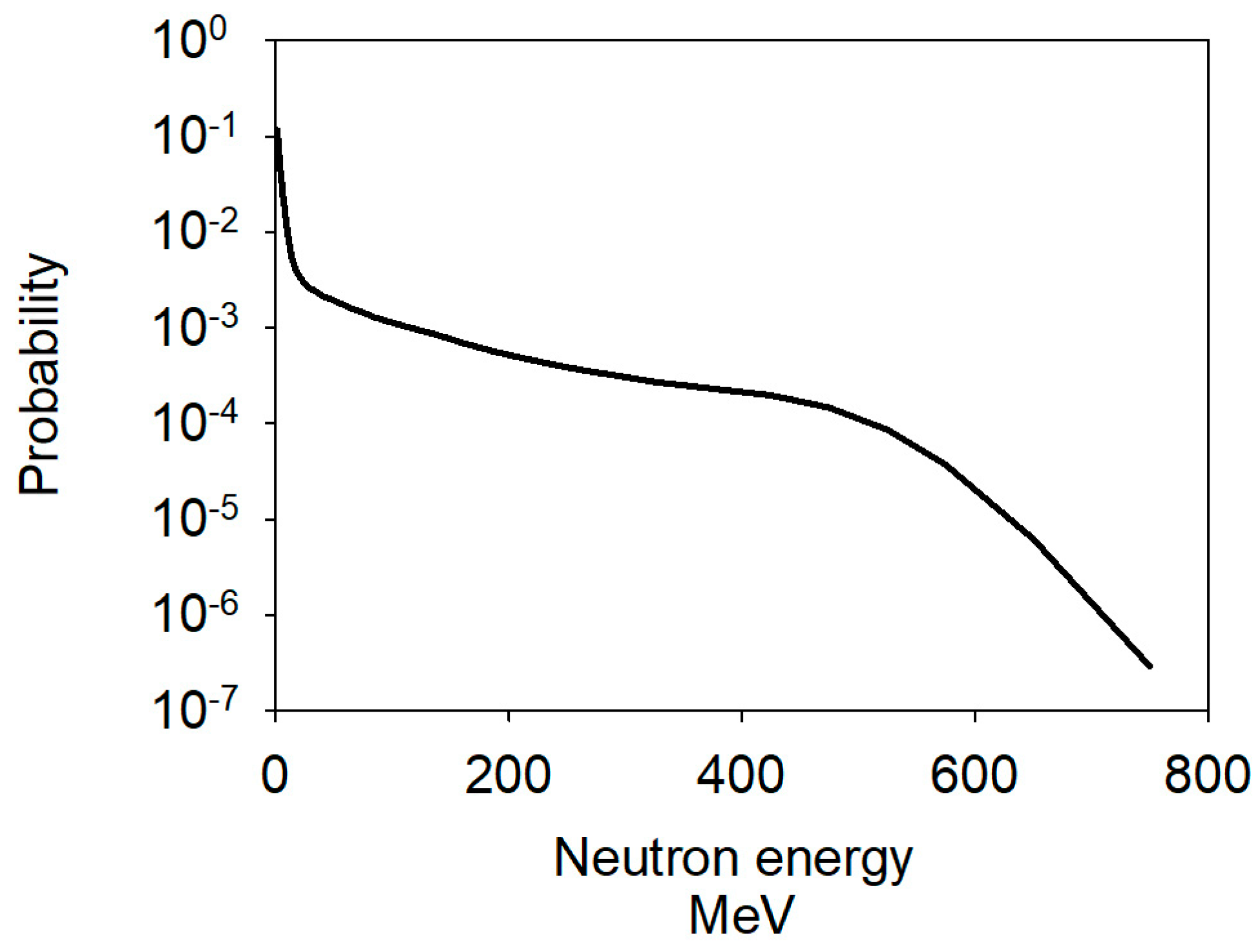

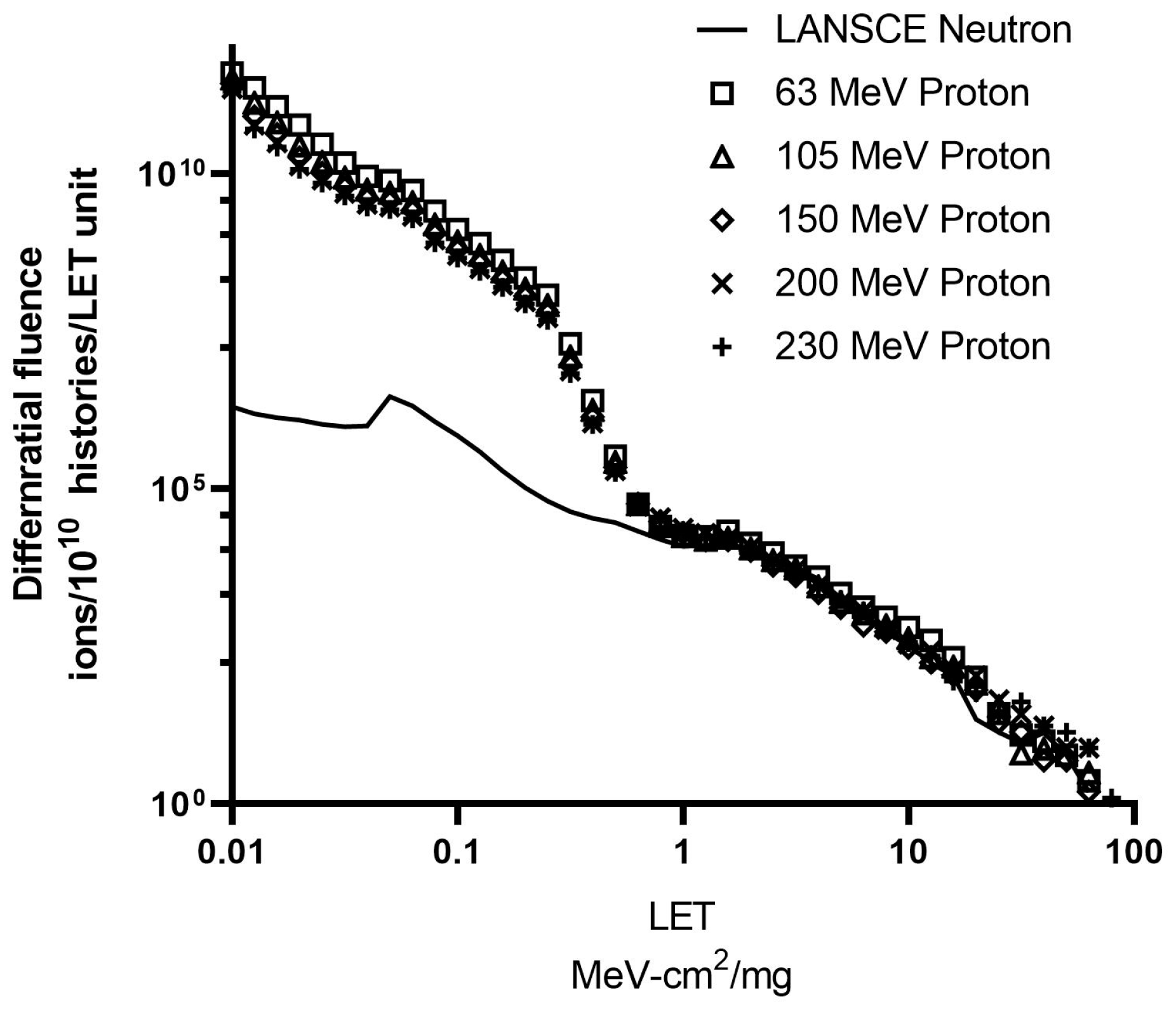
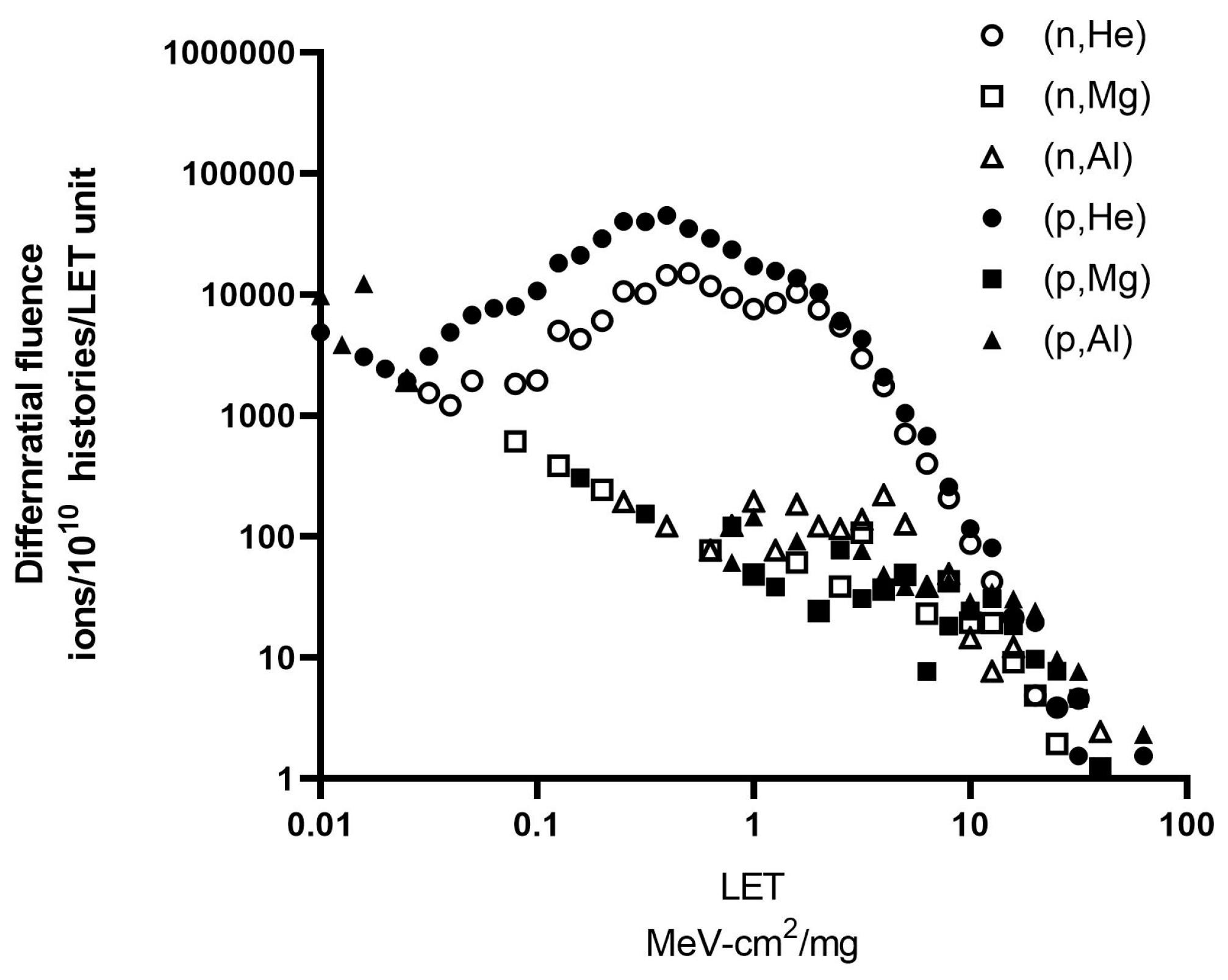
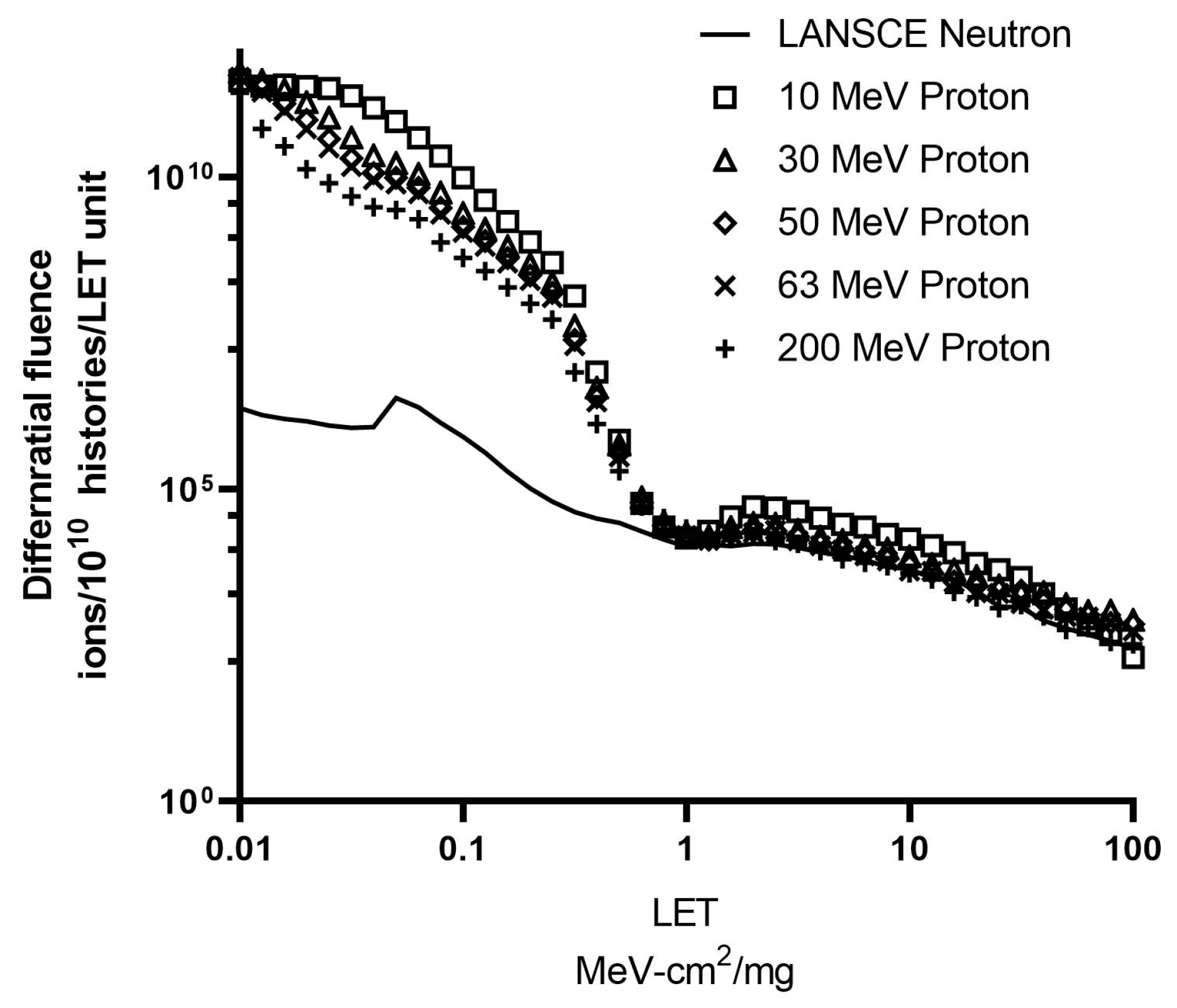
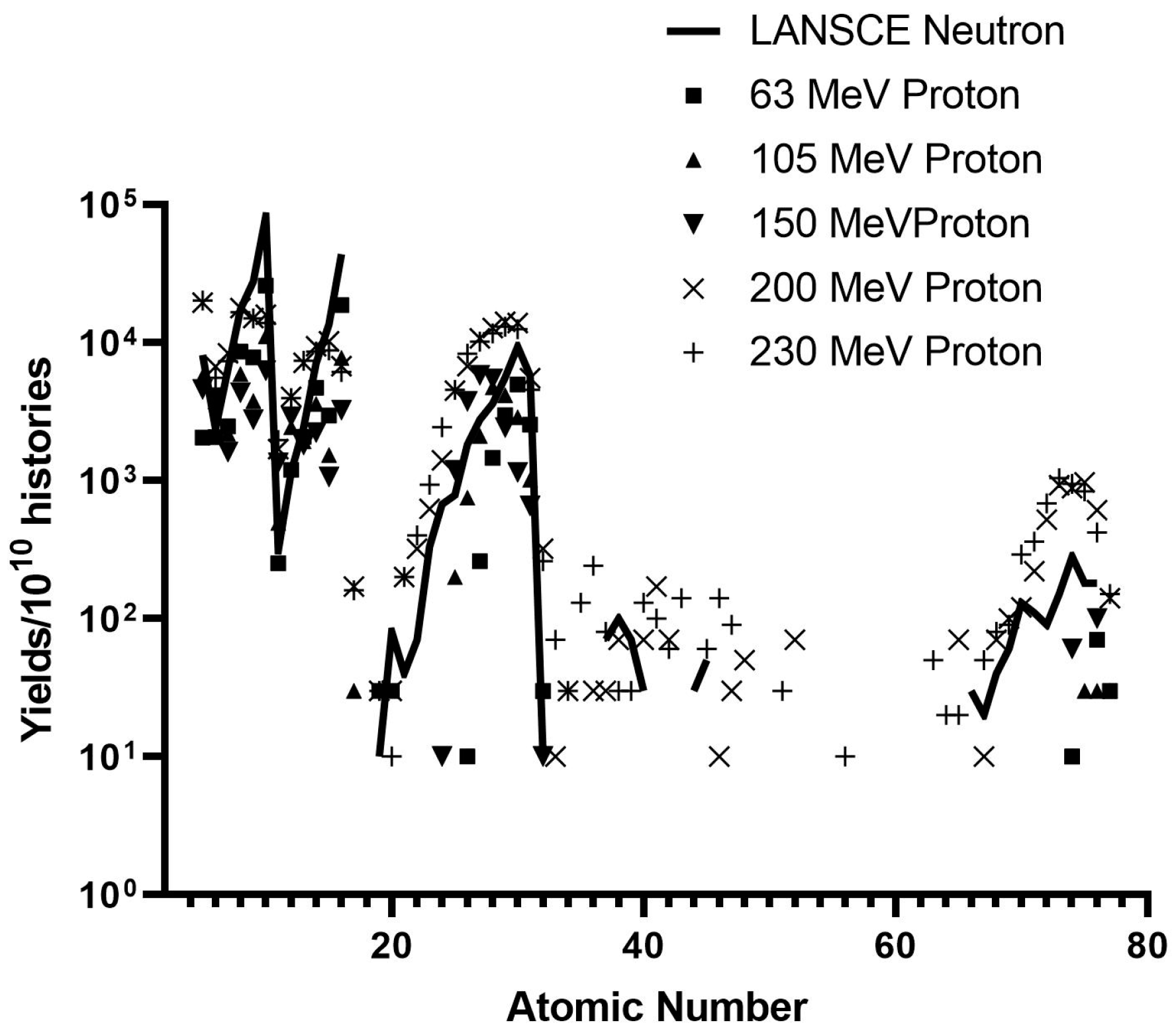

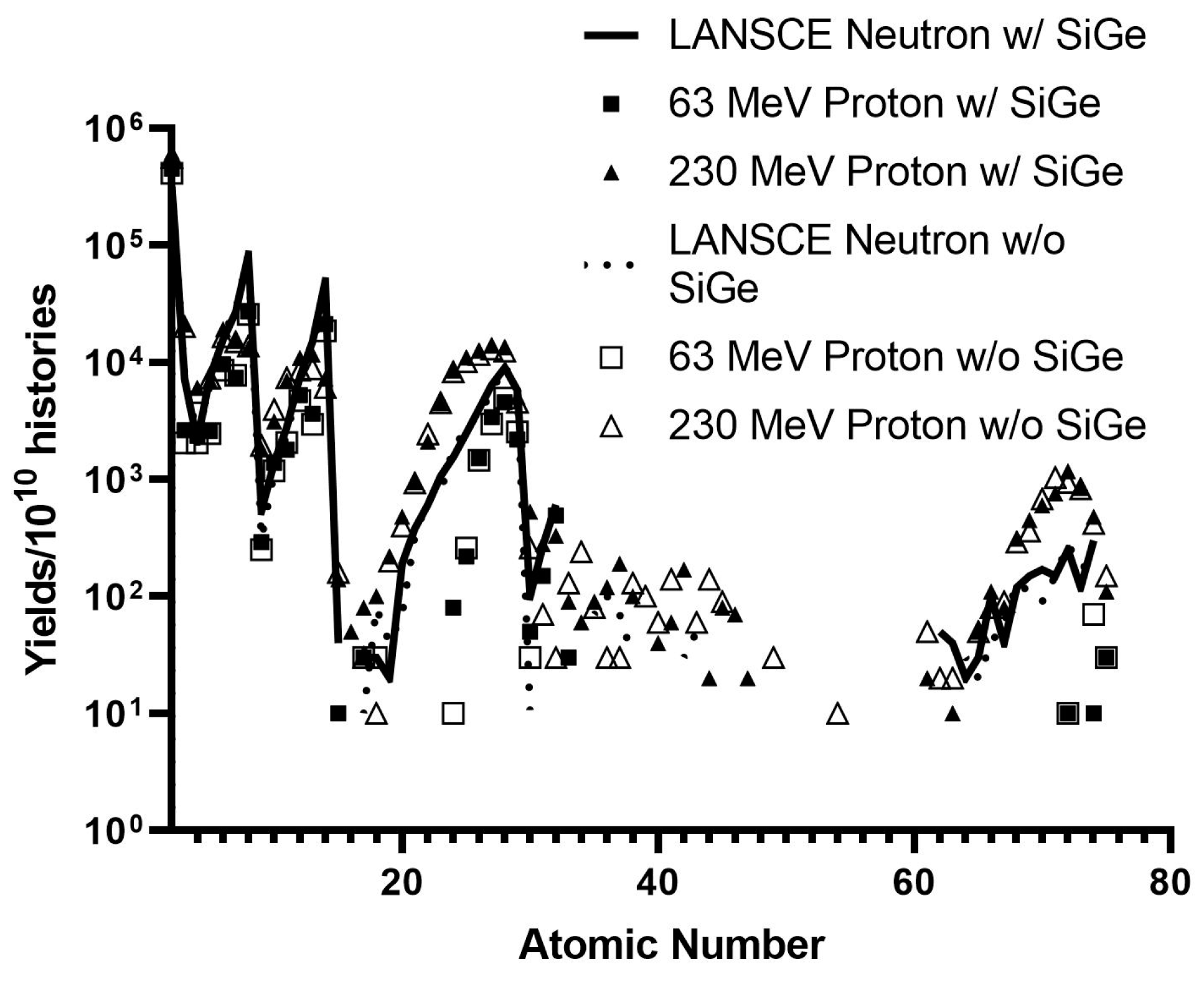
| LANSCE Neutron | 63 MeV Proton | 105 MeV Proton | 150 MeV Proton | 200 MeV Proton | 230 MeV Proton | |
|---|---|---|---|---|---|---|
| EI | 0 | 0.290 | 0.274 | 0.296 | 0.250 * | 0.285 |
| LANSCE Neutron | 63 MeV Proton | 105 MeV Proton | 150 MeV Proton | 200 MeV Proton | 230 MeV Proton | |
|---|---|---|---|---|---|---|
| EI | 0 | 0.560 | 0.544 | 0.543 | 0.405 * | 0.443 |
| LANSCE Neutron | 63 MeV Proton | 105 MeV Proton | 150 MeV Proton | 200 MeV Proton | 230 MeV Proton | |
|---|---|---|---|---|---|---|
| EI | 0 | 0.237 | 0.256 | 0.258 | 0.228 * | 0.257 |
| LANSCE Neutron | 63 MeV Proton | 105 MeV Proton | 150 MeV Proton | 200 MeV Proton | 230 MeV Proton | |
|---|---|---|---|---|---|---|
| EI | 0 | 0.550 | 0.541 | 0.524 | 0.381 * | 0.533 |
| LANSCE Neutron | 63 MeV Proton | 105 MeV Proton | 150 MeV Proton | 200 MeV Proton | 230 MeV Proton | |
|---|---|---|---|---|---|---|
| Energy deposited (GeV) Cv <0.01% | 2.7019 | 15,910 | 10,680 | 8213.4 | 6750.3 | 6165.4 |
| LET >1 (counts) Cv <0.7% | 28,570 | 38,260 | 30,070 | 25,730 | 31,500 | 29,960 |
| LET >10 (counts) Cv <3% | 1200 | 2500 | 1680 | 1370 | 2310 | 1920 |
| Energy deposited/LET >1 (keV) Cv <3% | 94.6 | 41,500 | 35,500 | 31,900 | 21,400 | 20,500 |
| Energy deposited/LET >10 (MeV) Cv <4.2% | 2.25 | 636 | 635 | 599 | 292 | 321 |
| LANSCE Neutron | 63 MeV Proton | 105 MeV Proton | 150 MeV Proton | 200 MeV Proton | 230 MeV Proton | |
|---|---|---|---|---|---|---|
| Energy deposited (GeV) Cv <0.01% | 2.4761 | 15,956 | 10,706 | 8232.0 | 6765.3 | 6181.3 |
| LET >1 (counts) Cv <0.7% | 27,460 | 36,700 | 30,350 | 26,010 | 32,040 | 31,510 |
| LET >10 (counts) Cv <3.2% | 980 | 2360 | 1680 | 1280 | 2160 | 2360 |
| Energy deposited/LET >1 (keV) Cv <3.3% | 90.2 | 43,500 | 35,300 | 31,600 | 21,100 | 19,600 |
| Energy deposited/LET >10 (MeV) Cv <4.6% | 2.52 | 676 | 637 | 643 | 313 | 261 |
© 2020 by the authors. Licensee MDPI, Basel, Switzerland. This article is an open access article distributed under the terms and conditions of the Creative Commons Attribution (CC BY) license (http://creativecommons.org/licenses/by/4.0/).
Share and Cite
Chiang, Y.; Tan, C.M.; Chao, T.-C.; Lee, C.-C.; Tung, C.-J. Investigate the Equivalence of Neutrons and Protons in Single Event Effects Testing: A Geant4 Study. Appl. Sci. 2020, 10, 3234. https://doi.org/10.3390/app10093234
Chiang Y, Tan CM, Chao T-C, Lee C-C, Tung C-J. Investigate the Equivalence of Neutrons and Protons in Single Event Effects Testing: A Geant4 Study. Applied Sciences. 2020; 10(9):3234. https://doi.org/10.3390/app10093234
Chicago/Turabian StyleChiang, Yueh, Cher Ming Tan, Tsi-Chian Chao, Chung-Chi Lee, and Chuan-Jong Tung. 2020. "Investigate the Equivalence of Neutrons and Protons in Single Event Effects Testing: A Geant4 Study" Applied Sciences 10, no. 9: 3234. https://doi.org/10.3390/app10093234
APA StyleChiang, Y., Tan, C. M., Chao, T.-C., Lee, C.-C., & Tung, C.-J. (2020). Investigate the Equivalence of Neutrons and Protons in Single Event Effects Testing: A Geant4 Study. Applied Sciences, 10(9), 3234. https://doi.org/10.3390/app10093234






